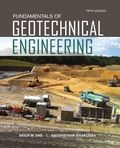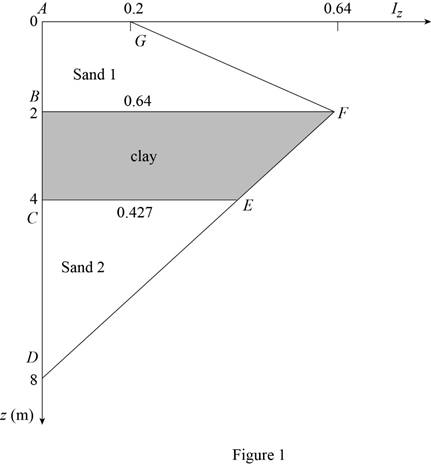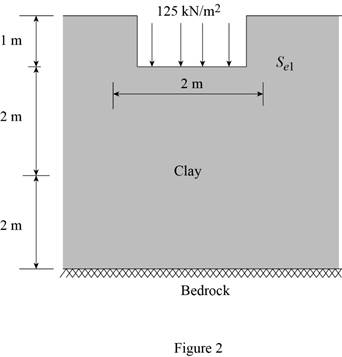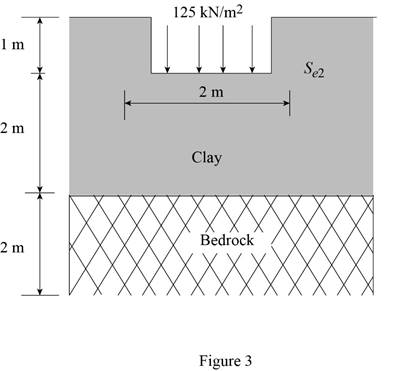
(a)
Find the settlement in sands in 10 years using the strain influence factor method.
(a)
Answer to Problem 17.17CTP
The settlement in sands in 10 years using the strain influence factor method is
Explanation of Solution
Given information:
The width (B) of the continuous foundation is 2.0 m.
The cone penetration resistance
The cone penetration resistance
The depth of footing
The thickness
The unit weight
The saturated unit weight
The stress
The elasticity of sand layer is
Calculation:
Find the applied stress (q) using the equation:
Substitute
Find the effective stress at the depth of
Substitute
Find the maximum value of strain influence factor
Substitute
Find the correction factor
Substitute
Find the correction factor
Substitute 10 years for t.
Find the elasticity of the sand layer
Substitute
Find the elasticity of the sand layer
Substitute
For continuous foundation
Sketch the strain influence diagram as shown in Figure 1.

Refer Figure 1.
Find the strain influence factor
Find the term
Find the term
Find the term
Substitute 0.84 m for
Find the settlement in sand
Substitute 0.92 for
Therefore, the settlement in sands in 10 years using the strain influence factor method is
(b)
Find the elastic settlement in the clay assuming undrained conditions.
(b)
Answer to Problem 17.17CTP
The elastic settlement in the clay assuming undrained conditions is
Explanation of Solution
Given information:
The elasticity of soil is
Calculation:
Consider two homogenous clay layers below the base of the foundation. One is the clay layer up to 4 m depth below foundation and another one is clay layer up to 2 m below foundation.
Sketch the cross section of clay layer 1 as shown in Figure 2.

Here, the depth of clay layer (H) is 4 m.
Find the ratio of depth of footing to breadth of footing
Substitute 1 m for
Find the ratio of length of footing to breadth of footing
Substitute
Find the ratio of depth of clay layer to breadth of footing
Substitute 4 m for H and 2 m for B.
Find the net applied pressure
Substitute
Find the factor
Refer Table 17.1, “Variation of
Take the value of
Determine the factor
Refer Table 17.2, “Variation of
Take the value of
Find the elastic settlement of clay layer 1
Substitute 0.975 for
Sketch the cross section of clay layer 2 as shown in Figure 3.

Here, the depth of clay layer (H) is 2 m.
Find the ratio of depth of footing to breadth of footing
Substitute 1 m for
Find the ratio of length of footing to breadth of footing
Substitute
Find the ratio of depth of clay layer to breadth of footing
Substitute 2 m for H and 2 m for B.
Find the net applied pressure
Substitute
Find the factor
Refer Table 17.1, “Variation of
Take the value of
Determine the factor
Refer Table 17.2, “Variation of
Take the value of
Find the elastic settlement of clay layer 2
Substitute 0.975 for
Find the elastic settlement of the clay layer
Substitute 6.7 mm for
Therefore, the elastic settlement in the clay assuming undrained conditions is
(c)
Find the consolidation settlement in the clay.
(c)
Answer to Problem 17.17CTP
The consolidation settlement in the clay is
Explanation of Solution
Calculation:
Find the increase in vertical stress at the top
Here, t is the thickness of the clay layer and
Substitute
Find the increase in vertical stress at the middle
Here,
Substitute
Find the increase in vertical stress at the bottom
Here,
Substitute
Find the average increase in vertical stress
Substitute
Find the initial effective over burden stress at the middle of the clay layer
Substitute 3 m for D,
Find the consolidation settlement in the clay
Substitute 0.4 for
Therefore, the consolidation settlement in the clay is
(d)
Find the settlement of the footing in 10 years.
(d)
Answer to Problem 17.17CTP
The settlement of the footing in 10 years is
Explanation of Solution
Calculation:
Find the settlement (total settlement) of the footing in 10 years
Substitute 7.55 mm for
Therefore, the settlement of the footing in 10 years is
Want to see more full solutions like this?
Chapter 17 Solutions
EBK FUNDAMENTALS OF GEOTECHNICAL ENGINE
- The given beam has continuous lateral support. If the live load is twice the dead load, what is the maximum total service load, in kips / ft, that can be supported? A992 steel is used: Fy = 50 ksi, Fu=65 ksi. Take L = 30 ft. bf For W40 x 149: 2tf = 7.11, = = 54.3, Z 598 in.³ tw W W40 X 149 L (Express your answers to three significant figures.) a. Use LRFD. Wtotal = kips/ft b. Use ASD. Wtotal kips/ftarrow_forwardThe beam shown in the figure below is a W16 × 31 of A992 steel and has continuous lateral support. The two concentrated loads are service live loads. Neglect the weight of the beam and determine whether the beam is adequate. Suppose that P = 52 k. For W16 × 31: d = 15.9 in., tw = 0.275 in., h/tw = 51.6, and M = M₁ = 203 ft-kip, Mn/₁ = Mp/α = 135 ft-kip. P Р W16 x 31 a. Use LRFD. Calculate the required moment strength, the allowable shear strength, and the maximum shear. (Express your answers to three significant figures.) Mu = OvVn = ft-kip kips kips Vu = Beam is -Select- b. Use ASD. Calculate the required moment strength, the allowable shear strength, and the maximum shear. (Express your answers to three significant figures.) Ma = Vn/b - Va = Beam is -Select- ft-kip kips kipsarrow_forwardDetermine the smallest value of yield stress Fy, for which a W-, M-, or S-shape from the list below will become slender. bf/2tfh/tw Shape W12 × 72 8.99 22.6 W12 × 26 8.54 47.2 M4 × 6 11.9 22.0 M12 x 11.8 6.81 62.5 M6 × 4.4 5.39 47.0 S24 × 80 4.02 41.4 S10 × 35 5.03 13.4 (Express your answer to three significant figures.) Fy = ksi To which shape does this value apply? -Select- ✓arrow_forward
- Compute the nominal shear strength of an M12 × 11.8 of A572 Grade 60 steel (Fy = 60 ksi). For M12 x 11.8: d = 12 in., tw = 0.177 in., h/tw = 62.5. Vn = kipsarrow_forwardA flexural member is fabricated from two flange plates 1/2 × 71/2 and a web plate 3/8 × 19. The yield stress of the steel is 50 ksi. a. Compute the plastic section modulus Z and the plastic moment Mp with respect to the major principal axis. (Express your answers to three significant figures.) Z = Mp = in. 3 ft-kips b. Compute the elastic section modulus S and the yield moment My with respect to the major principal axis. (Express your answers to three significant figures.) S = My = in.3 ft-kipsarrow_forward= 65 ksi. A W16×36 of A992 steel has two holes in each flange for 7/8-inch-diameter bolts. For A992 steel: Fy = 50 ksi, Fu For a W16×36: bƒ = 6.99 in., tƒ = 0.430 in., Z = 64.0 in.³ and Sx = 56.5 in.³ a. Assuming continuous lateral support, verify that the holes must be accounted for and determine the nominal flexural strength. (Express your answer to three significant figures.) Mn = ft-kips b. What is the percent reduction in strength? (Express your answer to three significant figures.) Reduction = %arrow_forward
- Find the reinforcements for the mid span and supports for an interior 9 in. thick slab (S-2) in thefloor from Problem 1. Ignore the beams and assume that the slab is supported by columns only (i.e.a flat plate). Sketch the slab and show the reinforcements including the shrinkage andtemperature reinforcement steel. Use f c’ = 4,000 psi and f y = 60,000 psi.NOTE: Problem 3 requires additional column placements at locations such as C and D. The stripof slab between these two columns will behave as a beam support to the one-way slab (with 10 ft.span). Problem 1. The figures below shows the framing plan and section of a reinforced concrete floor system.Floor beams are shown as dotted lines. The weight of the ceiling and floor finishing is 6 psf,that of the mechanical and electrical systems is 7 psf, and the weight of the partitions is 180psf. The floor live load is 105 psf. The 7 in. thick slab exterior bay (S-1) is reinforced with #5rebars @ 10 in. o.c. as the main positive…arrow_forward1- A study of freeway flow at a particular site has resulted in a calibrated speed-density relationship, as follows u = 57.5(10.008k) a) Find the free-flow speed and jam density b) Derive the equations describing flow versus speed and flow versus density c) Determine the capacity of the road 2- A rural freeway has a demand volume of 6750 v/hr. It has four 3.4 m lanes in each direction. The traffic stream is comprised of 8% heavy vehicles and a PHF of 0.94. The terrain is rolling throughout the segment. What is the level of service for the facility? What is the capacity? 3- For an urban freeway, how many 3.6 m lanes in each direction are needed to achieve LOS C on a freeway with a peak hour traffic volume of 5725 v/hr and with a PHF = 0.967 The traffic stream is comprised of 11% heavy vehicles and the location is level terrain.arrow_forwardNote: Provide a clear, step-by-step simplified handwritten solution (with no extra explanations) that is entirely produced by hand without any AI help. I require an expert-level answer, and I will assess it based on the quality and accuracy of the work, referring to the attached image for additional guidance. Make sure every detail is carefully verified for correctness before you submit. Thanks!.arrow_forward
 Principles of Foundation Engineering (MindTap Cou...Civil EngineeringISBN:9781337705028Author:Braja M. Das, Nagaratnam SivakuganPublisher:Cengage Learning
Principles of Foundation Engineering (MindTap Cou...Civil EngineeringISBN:9781337705028Author:Braja M. Das, Nagaratnam SivakuganPublisher:Cengage Learning Principles of Foundation Engineering (MindTap Cou...Civil EngineeringISBN:9781305081550Author:Braja M. DasPublisher:Cengage Learning
Principles of Foundation Engineering (MindTap Cou...Civil EngineeringISBN:9781305081550Author:Braja M. DasPublisher:Cengage Learning Principles of Geotechnical Engineering (MindTap C...Civil EngineeringISBN:9781305970939Author:Braja M. Das, Khaled SobhanPublisher:Cengage Learning
Principles of Geotechnical Engineering (MindTap C...Civil EngineeringISBN:9781305970939Author:Braja M. Das, Khaled SobhanPublisher:Cengage Learning Fundamentals of Geotechnical Engineering (MindTap...Civil EngineeringISBN:9781305635180Author:Braja M. Das, Nagaratnam SivakuganPublisher:Cengage Learning
Fundamentals of Geotechnical Engineering (MindTap...Civil EngineeringISBN:9781305635180Author:Braja M. Das, Nagaratnam SivakuganPublisher:Cengage Learning



